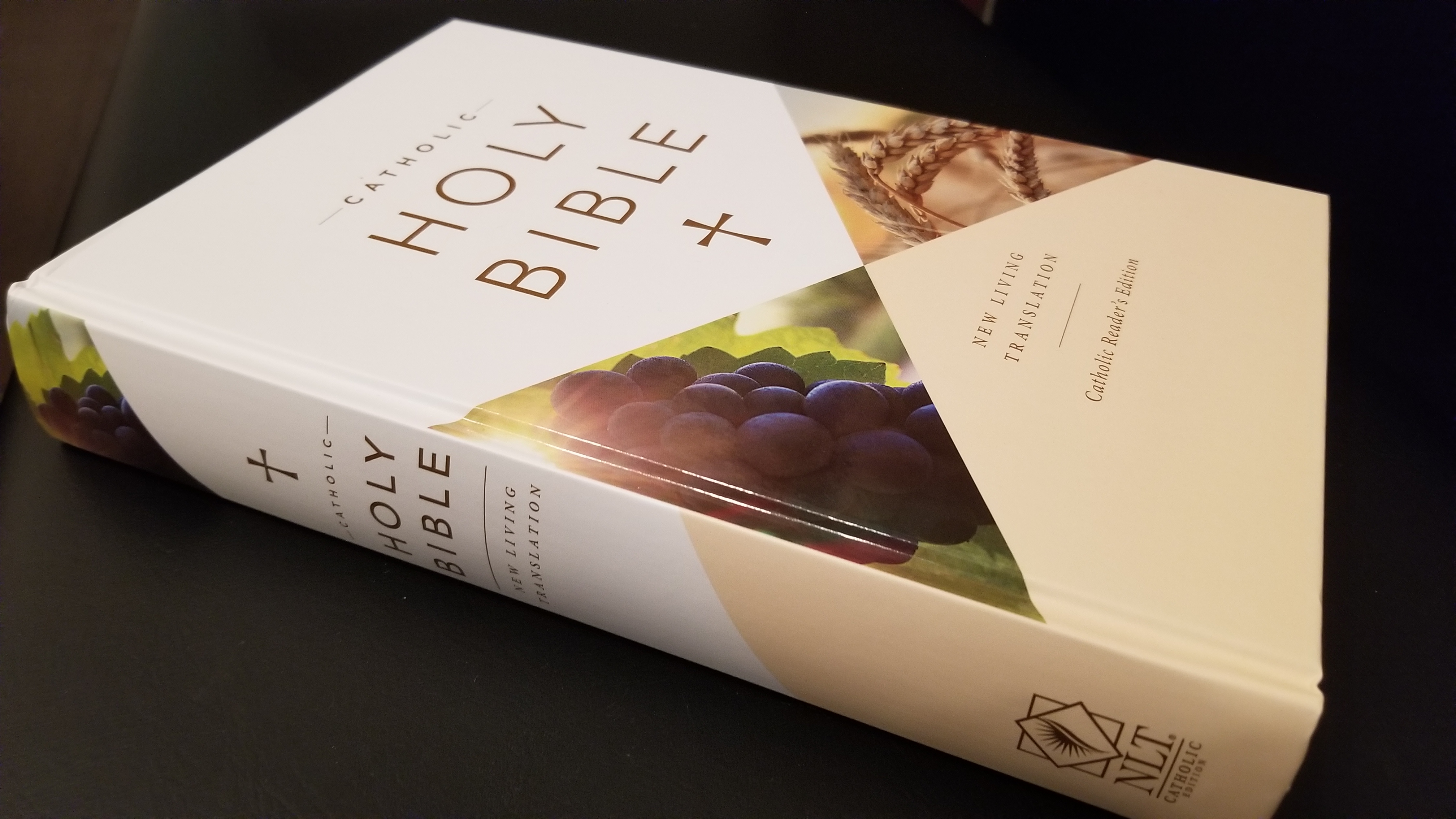
In 2016, the Conference of Catholic Bishops of India (CCBI) and Asian Trading Corporation (ATC) released the New Living Translation – Catholic Edition (NLT-CE). ATC Publishers produced a few editions of the Bible in India, and last year, Tyndale House Publishers released a hardcover edition in the US. I recently purchased a copy, and I’ll be spending some quality time with it over the next several days, reading through the Gospel of Matthew and 1 Corinthians. I have very little experience with the NLT prior to this, so I’m looking forward to getting familiar with it. If you would like me to take a look at a particular passage, feel free to ask!
For anyone unfamiliar with the NLT, here’s a brief summary of its history: The NLT serves as a scholarly update to the Living Bible. Kenneth Taylor published the original Living Bible in 1971, in which he paraphrased the text of the American Standard Version (the precursor to the Revised Standard Version). A Catholic Edition of the Living Bible was released, complete with the imprimatur, and I have occasionally run into copies of it over the years.
In the late 1980s, Tyndale House Publishers invited a team of scholars to revise the text of the Living Bible. The revision was released in 1996 under the name “New Living Translation.” Tyndale House published a Catholic Reference edition of the NLT in 2002, but that edition was never granted an imprimatur.
The text of the NLT was revised in 2004, with additional minor revisions in later years. The bible text used in the NLT-CE is copyrighted in 2015.
A committee of scholars from the Conference of Catholic Bishops of India reviewed the NLT. In the process, they suggested changes to the text, which were accepted by Tyndale House. There is currently no list of those changes available. ATC Publishers plans to release more information on the changes at a future date.

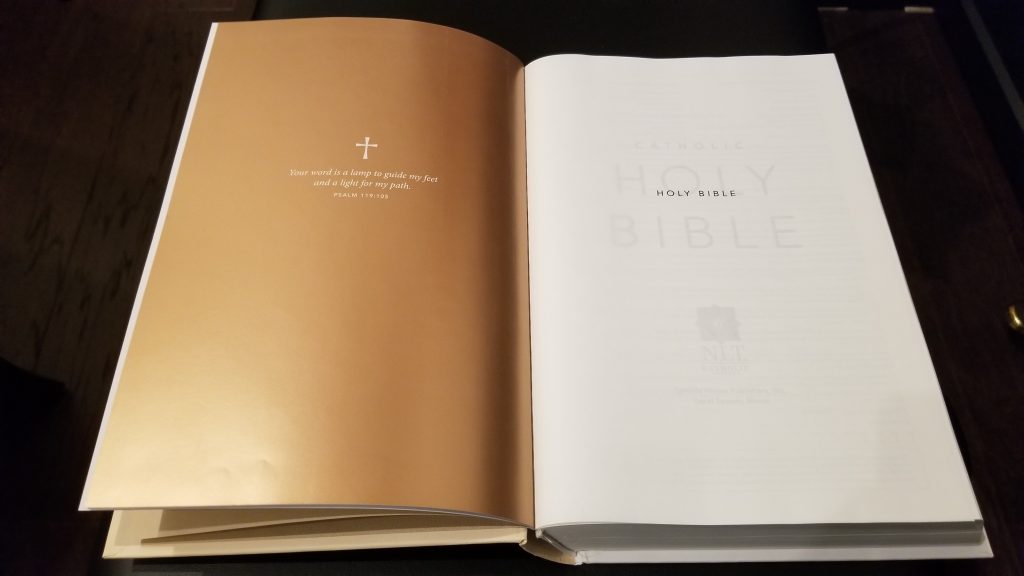
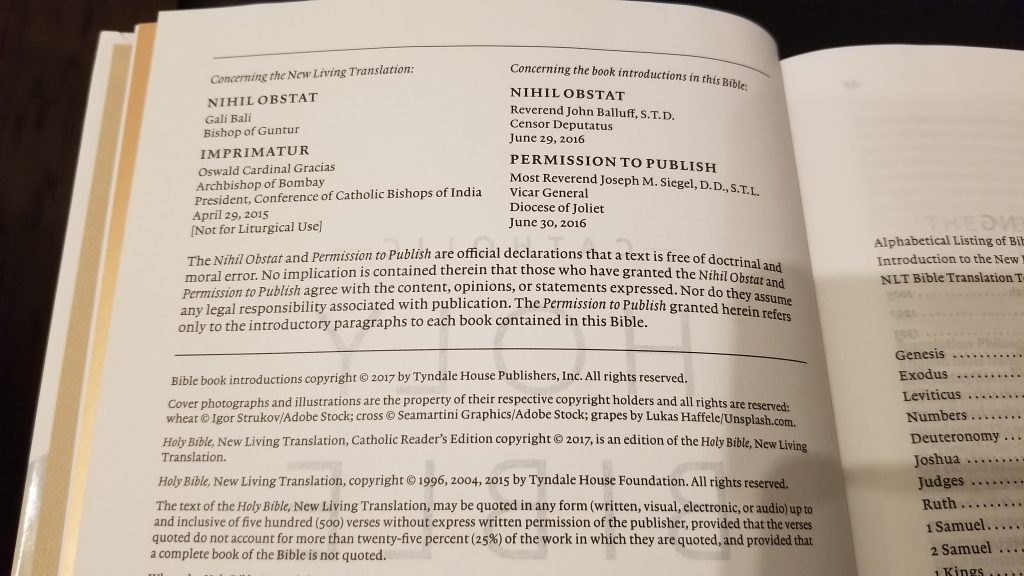
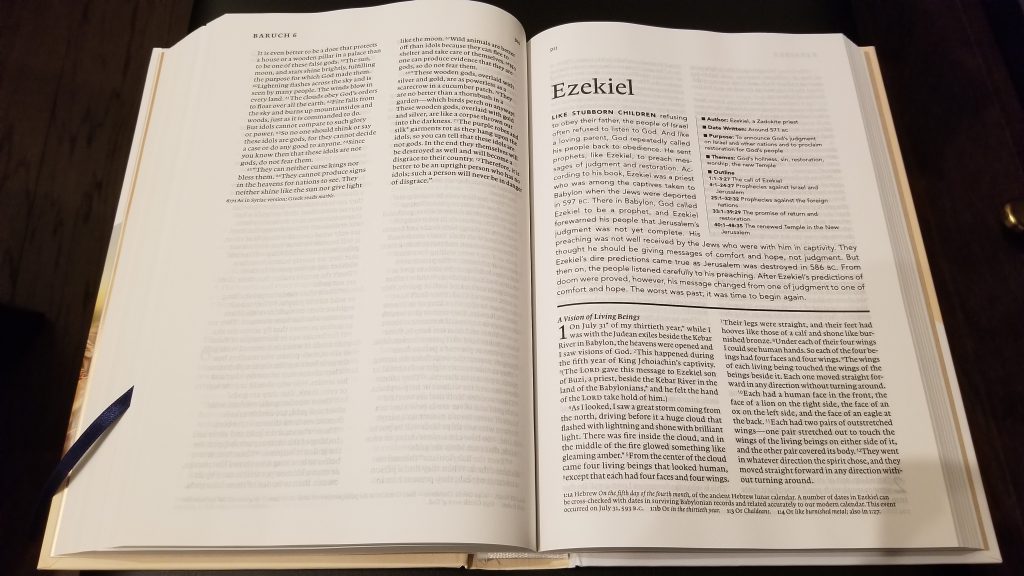
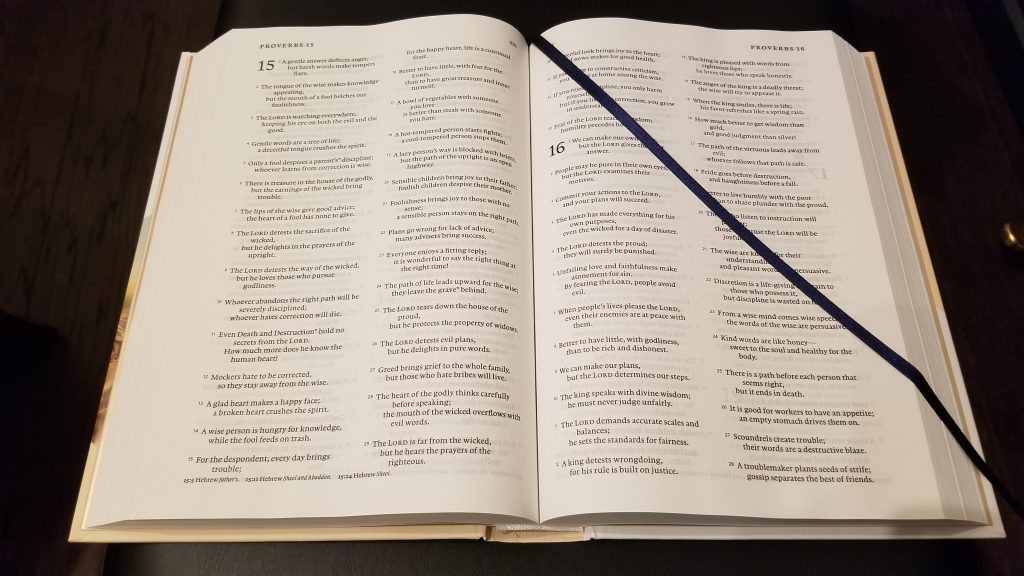

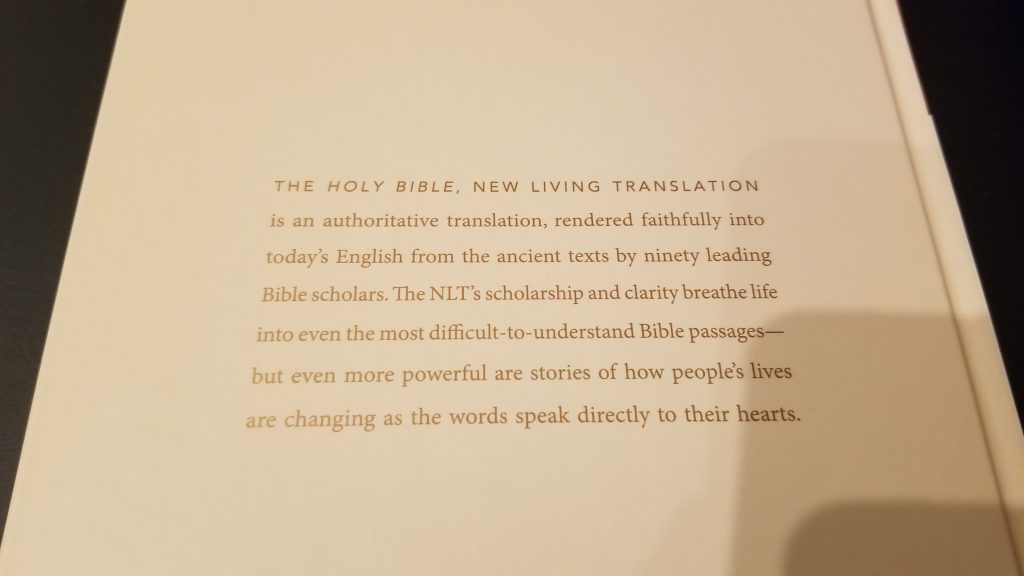
I am not a fan of the Living Bible, or of other translations that are written at that reading level.
But before I make any specific complaints, I would like to hear what others have to say about it,
I have been reading the Catholic One Year Bible (which is Catholic Living Bible translation) for over a year now and I have seen many things in the translation that make me wonder how the Catholic Church gave the Living Translation an Imprimatur. When I contrast it with its successor, the NLT, I’m not much more impressed, though it is a little better, admittedly, but still causes me to scratch my head in how it got an Imprimatur.
I was once a very active Evangelical Protestant so I can tell when things seem a little…off. And the Living Translation takes many many liberties “translating” Holy Scripture with a VERY loaded Protestant view. The NLT is not much better
For example, look at Galatians 5:11. Living Bible: “Some people even say that I myself am preaching that circumcision and Jewish laws are necessary to the plan of salvation. Well, if I preached that, I would be persecuted no more—for that message doesn’t offend anyone. I am still preaching salvation through faith in the cross of Christ alone”. (Holy Sola Fide Batman!)
NLT now: “Dear brothers and sisters, if I were still preaching that you must be circumcised—as some say I do—why am I still being persecuted? If I were no longer preaching salvation through the cross of Christ, no one would be offended.” (Glad they dropped the blatant “alone”, but still pushes Sola Fide pretty hard, seriously, looks at a literal translation below)
For arguments sake, here is the same verse in the prominent Protestant translation “New King James Version: “And I, brethren, if I still preach circumcision, why do I still suffer persecution? Then the offense of the cross has ceased” (No Sola Fide here). Offense of the cross has ceased. Very very different than “salvation through the cross or salvation through the cross alone”.
Even old school King James that fundamentalists claim is the only inspired translation uses the phrase “then is the offense of the cross ceased”.
This is only one example of the liberties taken in the “Living Translations”. Remember, they are “thought for thought paraphrased” translations. Well, whose “thought” are you getting?
Reading the Living Translation or NLT is better than not reading at all. NLT is much better than the first Living Translation and May be a good tool to instruct young ones. But make sure you are sound on your Catholic foundation because these translations are written with a very clear evangelical bias.
It appears that the commenter is comparing “apples to oranges”. “The Living Bible” was a paraphrase from the 1970’s. “The New Living Translation” is a translation of the Bible into English by Hebrew, Aramaic, and Greek scholars in the 1990’s. The New Living Translation (NLT) is an excellent translation. As English has changed and new manuscripts have been found, the NLT has been updated since then.
The commenter’s memory and comparison of the Living Bible (LB) paraphrase text to other translated versions will show there are differences, but he is mislabeling it the “Living Translation”, it was a paraphrase. Ken Taylor wanted the Bible to be understandable to children. The Catholic One Year Bible (published in 1987) is an LB, not an NLT.
I have reached the point I read a Bible passage first in the NLT – New Living Translation, then if I desire more information, I will read it in other versions.
In regard to the NLT-CE (New Living Translation – Catholic Edition) the Catholic Biblical Federation wrote “The scholars read their assigned book or books in the NLT both to ensure that it is a faithful translation of the original texts, and to ensure that nothing in the text had been translated in a way that was contrary to Catholic teaching.” Doing a word-for-word translation of text from one language to another, and keeping the words in the same order, does not assure the accuracy of understanding in the receiving language. The thought-for-thought balance is needed to help readers understand the original meaning. Have you ever heard “Oh, that’s what he meant.”?
I hope Michael will try reading the Catholic Holy Bible Reader’s Edition, ISBN: 978-1-4964-1401-4.
ISBN: 9781496414014
Or the NLT Giant Print Bible, ISBN: 978-1-4964-4497-4 ISBN: 9781496444974
For speakers of today’s modern English, including those who speak English as their second or third language, the NLT will provide understanding of God’s love imparted to them.
I too have become a fan of the NLT –
I got the “Inspire” edition – it’s a lot more understandable
I like the Catholic NLT
The old Living Bible was a paraphrase. The NLT is a Translation.
I absolutely love the NLTCE translation. I teach theology at a Catholic high school and find that it works best with that population. I would place it in between the Good News Bible and the NABRE. My own preference is the RSV2CE but that translation is at times too literal for high school students.
Thank you for the context of where you would place it and your translation preference.
I’m a cradle catholic adult and I found reading the Bible confusing and contradictory, thus I just didn’t do it. However this past Easter I decided to try again to read the Bible cover to cover (I’m actually reading the Gospels a chapter at a time and at the same time going back and reading the Old Testament. My grandmother gave me a copy of The Living Bible (c. 1971) as a wedding present and so it is the Bible I’m reading now and I LOVE it because it takes the guess work out of what I’m reading. My only concern is that when human hands touch God’s word are we sure that we are making an correct translation. In the end it is more important for me to understand what I’m reading and maybe not be 100% exact then to read and be left confused. Now that it has been over a year I’m wondering What your opinion of the New Lliving Bible, Catholic Addition, is and how it compares
I am Roman Catholic and I am going out I need to get a new one or at least a used one. I am overwhelmed at how many translations and revisions there are to the Bible I think the Lord wants us to read the Bible, absorb it, apply it to our daily living so I just want to Bible that doesn’t stray far from the King James but that I can understand what I’m reading. Why do we make things so complicated , in the days of of Our Lord it was simple so when I looked up what Bible to read I could not believe my eyes! So if anyone has any suggestions it would be much appreciated
Thank you for commenting, Lisa. If you’re looking for something that is close to the King James but still understandable, I would recommend one of the translations in the King James lineage. These include the Revised Standard Version, Second Catholic Edition (RSV-2CE), the English Standard Version, Catholic Edition (ESV-CE), or the New Revised Standard Version (NRSV). All of those translations retain the flavor of the King James while using modern English without “thee” and “thou.” The New Living Translation, which this blog post covers, would be easier to understand than any of the translations I just mentioned, but it also won’t sound very similar to the King James.
Revised Standard Version – Second Catholic Edition. This year a well known priest Fr Mike Schmitz is doing a ‘Bible in a Year’ podcast. There is a reading plan and he reads and comments about 20m a day. It’s very good. I started late but that’s fine. He is using this version printed in The Great Adventure Catholic Bible format which people are raving about. Out of stock now but I’m waiting.
If you’re interested, I reviewed the Great Adventure Catholic Bible here:
http://catholicbibletalk.com/2018/09/first-look-great-adventure-bible-rsv-2ce-from-ascension-press/
There are other editions of the RSV-2CE to choose from. Ignatius Press publishes the RSV-2CE in paperback, hardcover, and imitation leather. Here’s a link to the hardcover edition, which I own and love:
https://www.amazon.com/Ignatius-Bible-Revised-Standard-Catholic/dp/0898708338/
I love the NLT except that a Catholic needs to be weary of the nuances in its choice of words. Having gifted a copy to one of my children, I now look forward to getting a Catholic version. Just as I have enjoyed the syntax and expression in the NLT (non-Catholic), I am sure this version has been sifted through by a body of Catholic leaders.
I’ll post a feedback once I have gotten hold and read a copy.
Perhaps the standard advice about telescopes for amateur astronomers could apply to Bibles: the best one is the one we are liable to use most often. The late great Fr Raymond E. Brown gave some advice on this subject in his Responses to 101 questions on the Bible. He says that some passages are hard to understand. Therefore translators have to choose whether to translate literally and preserve the ambiguities in the original, or translate freely, which means sometimes making educated guesses as to the meaning. Therefore a free translation is easier to understand but harder to use for close study. An obvious solution is to get one of each: GNB or NLT for a free translation, RSV or ESV for closer study. The REB (which I favour) and RNJB (or NJB) fall in the middle.
I grew up both Catholic and Protestant. They used the lovely King James Version. However, as a 12 year old I experienced complexity in understanding. Religion felt unattainable. In 1972, I got a copy of the Living Bible Paraphrase. My heart bloomed. Intimacy with God grew. And I couldn’t stop reading it!
Lucky you! I have read a similar testimony regarding the Douay-Rheims, in Thomas Nelson’s “Which Bible should you read”, by a convert called Sister Shiva Kumari (she had been a convert to Hinduism previously, from a US Methodist background). She confessed finding a modern translation unsatisfying, and then wrote: “The minute I touched the Douay-Rheims, I knew this was it! … when I read it, everything comes alive with God’s light, love and guidance.” She got defensive when another version was recommended to her; I’m sure you would sympathise, if you felt like that about the LB.
I wouldn’t discourage anyone using a translation that evidently suited them. That said, it’s good that websites like Bible Gateway enable people to try out different translations.
I think St Jerome’s comment so true “ignorance of Scripture is ignorance of Christ”.
Im a Catholic convert (from evangelical fundamentalism), im grateful to them for the love of Scripture but by grace i found the fulness of faith in he Catholic church.
The NLT in galatians tries to “squeeze in :)” the faith alone etc.. its not a bad read though.
I now regulary use the community catholic pastoral edition for my meditations but for serious study the excellent Ignatius catholic study bible edited by Dr Scott Hahn (also a convert but extremely knowlegeable).
I end reminding of St Jeromes saying again as “Ignorance of Scripture is ignorance of Christ”.
Whatever your “label” may His precious Word speak & bless you.
john therese t.o.carm
I also love the NLT-CE. Though i wish there was a translation that took a similar approach through an exclusively Catholic perspective. Because there are some minor issues. For example, the immaculate conception could be made more explicit – favored woman does not give the same level of gravitas to her situation as full of grace. And the perpetual virginity is not clear when using the word “until” in Matthew or in calling James, Joseph, and Jude his brothers rather than cousins.
I hope someone can make a translation like that
Yeah, it looks like we really don’t have a lot of fresh, original, Catholic translations.